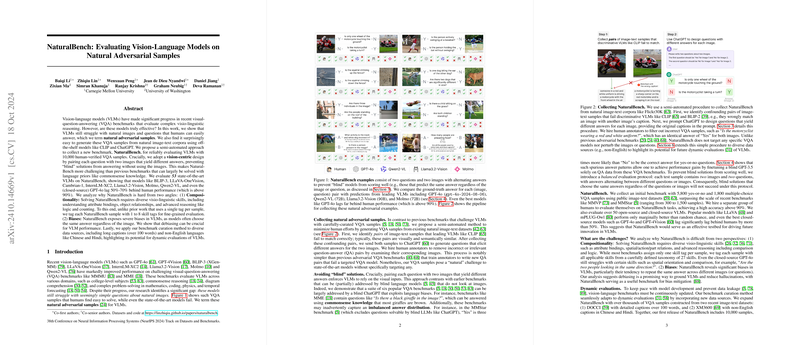Overview of NaturalBench: Evaluating Vision-LLMs on Natural Adversarial Samples
This paper introduces NaturalBench, a benchmark designed to evaluate vision-LLMs (VLMs) on what the authors term natural adversarial samples. The foundation of this work rests on the observation that even state-of-the-art VLMs struggle with basic visio-linguistic tasks when confronted with these natural adversarial instances. This finding prompts a critical reevaluation of the actual capabilities of VLMs.
Key Contributions
The paper's central contribution is the proposal of NaturalBench, a benchmark crafted using a semi-automated process that reduces human curation effort. This benchmark contains 10,000 VQA samples, each meticulously verified by humans to ensure accuracy and relevance. NaturalBench uniquely challenges models by pairing each question with two images that result in different answers, compelling the models to utilize visual information effectively and averting reliance on language biases or shortcuts.
Methodology
The collection process employs a novel approach, integrating off-the-shelf models like CLIP and ChatGPT to generate VQA samples from existing image-text datasets such as Flickr30K and DOCCI. Importantly, these images are paired based on a semi-automated identification of confounding pairs that current VLMs find challenging, ensuring the benchmark's difficulty aligns with the models' current limitations.
Evaluation and Findings
The authors evaluate 53 state-of-the-art VLMs across NaturalBench and uncover a significant performance gap between models and human participants, with models lagging by 50%-70% in accuracy. The analysis reveals that the models' difficulties stem notably from biases towards certain answers and challenges in handling compositionality, including skills like attribute bindings and complex reasoning.
Implications and Future Developments
The implications of NaturalBench are profound. Practically, it acts as a testbed for enhancing VLMs by highlighting specific shortcomings. Theoretically, it poses questions about the models' real understanding versus their ability to leverage language priors.
This benchmark sets the stage for potentially transformative changes, encouraging the development of models that are less reliant on language shortcuts and more robustly grounded in visual context. Future advancements might involve dynamic benchmarking protocols to accommodate ongoing model evolutions, ensuring benchmarks remain challenging and relevant.
Conclusion
The development of NaturalBench marks a significant stride in vision-language evaluation. By emphasizing a balanced, compositionally challenging dataset, it provides a more rigorous and nuanced measure of VLM capabilities. This benchmark not only signifies current challenges in VLM development but also highlights future avenues for research, particularly in addressing biases and enhancing compositional reasoning skills. The scalability of the benchmark collection method opens up further dynamic evaluation opportunities, driving the evolution of VLMs towards more authentic visio-linguistic comprehension.
